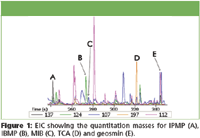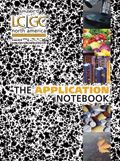Analysis of Trace Odorants in Drinking Water by Headspace-Solid Phase Microextraction-Gas Chromatography-Time of Flight Mass Spectrometry
Odor causing compounds can find their way into drinking water from a number of sources. One of the most common compounds causing a "musty" or "earthy" smell is geosmin, which is released when microbes such as blue-green algae and actinobacteria die.
Joe Binkley, LECO Corporation
Odor causing compounds can find their way into drinking water from a number of sources. One of the most common compounds causing a "musty" or "earthy" smell is geosmin, which is released when microbes such as blue-green algae and actinobacteria die. Other well known odor causing compounds that originate from natural sources include 2-methylisoborneol and methoxypyrazines. Many of these compounds are of interest since they have very low odor thresholds, often in the parts per trillion (ppt) range. Therefore, it is important to have an analytical method capable of detecting them at trace levels. This application note highlights a modified method 6040D showing an automated headspace-solid phase microextraction (HS-SPME) sampling approach coupled to GC-TOFMS. GC-TOFMS provides the sensitivity required for detection of targeted odorants while also allowing detection and identification of nontargeted odorant compounds.
Experimental
Odorant standards were prepared in water at concentrations ranging from 2.5 to 100 ppt. A 10 mL aliquot of each water
standard was placed in respective 20 mL headspace autosampler vials containing 2.5 grams of NaCl. Standards were analyzed by HS-SPME-GC-TOFMS using a LECO TruTOF HT GC-TOFMS system. The conditions used are shown below.
Sample Introduction: Gerstel MPS2 Autosampler
SPME Fiber: 2 cm, DVB/Carboxen/PDMS
Incubation Temperature: 65 °C
Extraction Time: 30 min
Desorb Time: 3 min @ 260 °C
GC: Agilent 6890
Injection: SPME, Splitless (60 s purge time)
Carrier Gas: He @ 1.5 mL/min
Column: Rxi-5 ms; 20 m × 0.18 mm × 0.18 mm
GC Oven: 60 °C (2 min), 30 °C/min to 250 °C (10 min hold)
MS Transfer Line: 280 °C
MS: LECO TruTOF
Saved mass range: 45–300 m/z
Acquisition rate: 20 spectra/s
Source temperature: 300 °C
Results and Discussion
This HS-SPME-GC-TOFMS approach demonstrated linearity across a calibration range of 2.5–100 ppt for each of the four odorant compounds. Their correlation coefficients averaged 0.9992.
Figure 1 shows the extracted ion chromatogram from the 5 ppt standard of 2-isopropyl-3-methoxypyrazine (IPMP), 2-isobutyl-3-methoxypyrazine (IBMP), 2-methylisoborneol (MIB), 2,4,6-trichloroanisole (TCA), and geosmin. The TCA was used as an internal standard for these analyses.

Figure 1
A major benefit of TOFMS for this application is the ability to reach these levels of detection while acquiring across a mass range of 45–300 m/z without sacrificing speed or sensitivity. This allows the analyst to confirm analyte identity using the deconvoluted full range mass spectrum, and to detect nontargeted compounds that may also be contributing to the aroma profile of the water sample.
For the complete version of this application note, please visit www.leco.com.
Reference
(1) Method 6040D, Developed by the American Water Works Association (AWWA).

LECO Corporation
3000 Lakeview Avenue, St. Joseph, MI 49085
tel. (269)985-5496; fax (269)982-8977
Website: www.leco.com

Separation of Ultra-Short and Long Chain PFAS Compounds Using a Positive Charge Surface Column
December 11th 2024A separation of ultra-short and long chain PFAS (C1-C18) is performed on a HALO®PCS Phenyl-Hexyl column along with a HALO®PFAS Delay column which demonstrates excellent retention for both hydrophilic and hydrophobic analytes.














